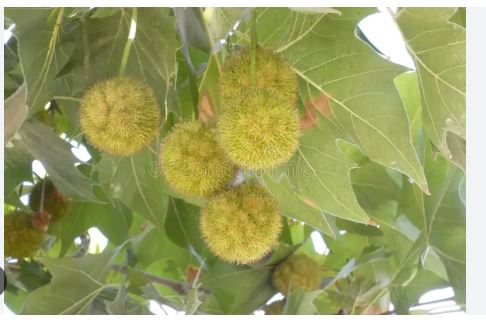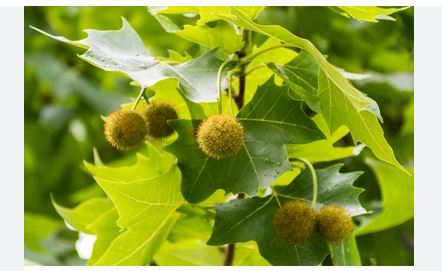
The Oriental Plane Tree (Platanus orientalis), often called the Old World Plane or Chinar, is a majestic deciduous tree revered for its expansive canopy, mottled bark, and deep cultural significance across its native range. Native to the eastern Mediterranean and western Asia, this tree has shaded historic landscapes for centuries, symbolizing longevity and beauty in Persian, Turkish, and Indian cultures.
Its resilience and aesthetic appeal make it a cherished choice for ornamental planting and urban landscapes. In this detailed guide, we explore the botanical classification, origin, identifying characteristics, habitat, distribution, USDA hardiness zones, uses, and fascinating facts about the Oriental Plane Tree.
Botanical Classification, Origin and Native Area
The Oriental Plane Tree, scientifically named Platanus orientalis, belongs to the Platanaceae family, a small family of broadleaf trees within the genus Platanus. The species name orientalis, meaning “eastern” in Latin, reflects its origins in the eastern Mediterranean and Asia. As an angiosperm, it produces flowers and seeds, with a monoecious reproductive system featuring separate male and female flowers on the same tree.
Its taxonomic relatives include the American Sycamore (Platanus occidentalis) and London Plane (Platanus × acerifolia), the latter a hybrid of P. orientalis and P. occidentalis. The species is distinct for its deeply lobed leaves and clustered seed balls, with cultivars like ‘Digitata’ emphasizing its ornamental traits. Its classification is stable, though its hybridization potential influences cultivated populations.
The Oriental Plane Tree is native to the eastern Mediterranean, from the Balkans and Greece through Turkey, and extends into western and southern Asia, including Iran, Iraq, and the Indian subcontinent (notably Kashmir). Its evolutionary history traces back to the Miocene, with Platanus fossils indicating a broader ancient distribution.
Known as “Chinar” in Kashmir, it holds profound cultural significance, planted in Persian gardens, Ottoman courtyards, and Mughal landscapes as a symbol of eternity. Ancient Greeks and Romans valued its shade, and Persian poets like Rumi referenced its grandeur. Introduced to Europe and North America for ornamental purposes, it remains a living link to historical landscapes, though its native populations face threats from urbanization and water diversion.
Identifying Characteristics

The Oriental Plane Tree is a large deciduous tree, typically growing 60–100 feet (18–30 meters) tall, with some specimens reaching 120 feet (36 meters) and a spread of 50–80 feet. Its canopy is broad and spreading, with a stout trunk and gnarled branches. The bark is mottled, peeling in patches to reveal a patchwork of creamy white, gray, and olive-green, creating a striking winter silhouette.
Leaves are large (5–8 inches wide), alternate, simple, and deeply palmately lobed with 5–7 narrow, pointed lobes, bright green in spring, turning golden-yellow to orange-red in fall. The tree produces spherical seed balls (1–1.5 inches), typically in clusters of 3–6 on long stalks, dispersing fuzzy achenes. Its slender twigs and small, conical buds add to its elegant structure.
Habitat
The Oriental Plane Tree thrives in riparian zones, including riverbanks, valleys, and floodplains, where it prefers moist, well-drained soils (pH 5.5–7.5), typically loamy or sandy. It is flood-tolerant, with roots adapted to periodic inundation, and requires full sun for optimal growth. In its native range, it grows in mixed forests with poplars, willows, and oaks, stabilizing soils and shading waterways.
In cultivation, it adapts to urban and suburban landscapes, parks, and large gardens, tolerating pollution, compacted soils, and moderate drought once established. Its deep root system can disrupt pavement, necessitating careful site selection. The tree excels in Mediterranean and temperate climates but may struggle in arid or poorly drained conditions without irrigation.
Distribution
The Oriental Plane Tree is naturally distributed from the eastern Mediterranean (Greece, Turkey, Cyprus) through the Middle East (Lebanon, Syria, Iran) to western and southern Asia (Afghanistan, Pakistan, northern India). In Kashmir, it is a cultural icon, with historic groves in Srinagar’s Mughal gardens.
It has been introduced to Europe (e.g., Italy, France, UK), North America (e.g., California, Virginia), and Australia for ornamental planting, often in urban areas or historic estates. The tree is not invasive but can naturalize in moist, disturbed sites near plantings. Its global spread reflects its ornamental value, though conservation efforts focus on preserving ancient groves in its native range, threatened by development and climate change.
USDA Hardiness Zones
The Oriental Plane Tree thrives in USDA Hardiness Zones 6–9, tolerating minimum temperatures from -10°F to 20°F (-23°C to -7°C). It is well-suited to Mediterranean and temperate climates with warm summers and mild winters, though it can endure light frost. In Zone 6, young trees may require protection from severe cold, while in Zones 8–9, they flourish with minimal care.
Its drought tolerance, once established, and flood resilience make it ideal for urban landscaping and riparian restoration, though supplemental irrigation is needed in arid regions during establishment.
Uses
The Oriental Plane Tree is prized for its ornamental, ecological, and cultural contributions. In landscaping, its mottled bark, deeply lobed leaves, and expansive canopy make it a stunning shade tree for avenues, parks, and historic gardens, though its shedding bark and seed balls require maintenance.
Ecologically, it stabilizes riverbanks, prevents erosion, and provides habitat for wildlife, including birds (e.g., warblers nesting in branches) and pollinators (e.g., bees visiting flowers). Its canopy shades aquatic ecosystems, benefiting fish. The wood, hard and coarse, is used for furniture, veneer, and crafts, though less commonly than American Sycamore.
In urban settings, it mitigates pollution, sequesters carbon, and cools environments. Culturally, it is a symbol of longevity in Persian and Mughal traditions, with historic trees protected as heritage landmarks in Kashmir and Turkey.
Fun Facts
The Oriental Plane Tree is steeped in captivating lore. In Kashmir, it is called “Chinar,” and ancient specimens, some over 600 years old, are revered as living monuments, planted by Mughal emperors. Its deeply lobed leaves, resembling an open hand, inspired Persian art and poetry, symbolizing hospitality.
The tree is less susceptible to anthracnose than American Sycamore, making it a hardier ornamental choice. A famous Oriental Plane in Kos, Greece, reputedly planted by Hippocrates, is said to be over 2,400 years old, though its age is debated. Its seed balls, known as “Chinar balls,” were used in traditional games in the Middle East. In Turkey, historic planes shade village squares, serving as communal gathering spots. Finally, its mottled bark, glowing in winter, has earned it the nickname “ghost tree” in some cultures, adding to its mystical allure.
Cultivation of Oriental Plane Tree (Platanus orientalis)
Cultivating the Oriental Plane Tree (Platanus orientalis), a majestic deciduous tree native to the eastern Mediterranean and western Asia, is a rewarding endeavor for gardeners, landscapers, and conservationists aiming to enhance landscapes with a culturally significant, shade-providing tree. Known for its mottled bark, deeply lobed leaves, and resilience, this tree, also called Chinar, is ideal for urban avenues, historic gardens, or riparian restoration projects. While adaptable, it requires careful management to accommodate its size, manage shedding, and prevent disease.
- Climate Suitability: Oriental Plane Tree thrives in USDA Hardiness Zones 6–9, tolerating minimum temperatures from -10°F to 20°F (-23°C to -7°C). It prefers Mediterranean or temperate climates with warm summers and mild winters. In Zone 6, protect young trees from severe frost to prevent branch dieback or leaf damage.
- Site Selection: Choose a spacious location with full sun, receiving at least 6–8 hours of direct sunlight daily, to support its broad, spreading canopy and vigorous growth. Ensure the site accommodates its mature size (60–100 feet tall, 50–80 feet wide) and avoid planting near buildings, sidewalks, or utilities due to its invasive roots and shedding bark.
- Soil Requirements: Plant in moist, well-drained soil with a pH of 5.5–7.5, preferably loamy or sandy, mimicking its riparian habitat. The tree tolerates clay and periodic flooding but thrives in fertile conditions. Test soil drainage and amend with organic matter (e.g., compost) if needed to enhance fertility without compromising aeration.
- Planting Time: The optimal planting seasons are early spring or fall, allowing roots to establish before summer heat or winter cold. Dig a hole twice as wide and as deep as the root ball, positioning the root collar at or slightly above ground level. Backfill with native soil, tamp gently, and water deeply to settle the roots and eliminate air pockets.
- Watering Needs: Water young trees deeply (1–2 times weekly) for the first 1–2 years to establish a strong root system, keeping soil consistently moist but not waterlogged. Once established, the tree is flood-tolerant and moderately drought-tolerant, requiring supplemental watering during prolonged dry spells, particularly in urban or arid settings.
- Mulching: Apply a 2–4 inch layer of organic mulch (e.g., wood chips, bark) around the base, extending to the drip line but keeping it 2–4 inches from the trunk to prevent rot. Mulch conserves moisture, regulates soil temperature, and suppresses weeds, supporting young trees in urban or garden settings. Replenish mulch annually to maintain effectiveness.
- Fertilization: Fertilize young trees in early spring with a balanced, slow-release fertilizer (e.g., 10-10-10) to promote healthy growth, applying at half the recommended rate to avoid excessive foliage at the expense of root development. Mature trees rarely need fertilization in fertile soils, as they are adapted to nutrient-rich riparian environments.
- Pruning: Prune in late winter or early spring to remove dead, damaged, or crossing branches and to shape the canopy, using clean, sharp tools to prevent disease spread. Young trees may need structural pruning to develop a strong central leader, especially for avenue plantings. Minimize cuts to reduce susceptibility to anthracnose or canker, and avoid heavy pruning to preserve its natural form.
- Pest and Disease Management: Monitor for pests like sycamore lace bugs, scale, or borers, treating infestations with insecticidal soap or neem oil. The tree is less susceptible to anthracnose than American Sycamore but may develop canker or powdery mildew in wet conditions; improve air circulation and remove infected debris to manage diseases. Ensure good drainage to prevent root issues.
- Spacing: Space trees 50–80 feet apart to accommodate their mature canopy spread, ensuring adequate sunlight and air circulation to reduce disease risk. For avenue plantings or urban designs, plant 30–40 feet apart to create a cohesive canopy. Consider their height (up to 100 feet) when planning near structures or power lines.
- Wind Protection: Young Oriental Planes, with shallow roots, are susceptible to windthrow in exposed areas. Stake newly planted trees for the first 1–2 years using flexible ties to allow slight trunk movement, which strengthens roots. Remove stakes once established to promote independent growth and prevent girdling.
- Winter Care: In Zone 6, protect young trees from winter damage by wrapping trunks with burlap to prevent frost cracks and mulching heavily around the base to insulate roots. Water adequately before freeze-up to prevent dehydration, as deciduous trees can lose moisture in winter. Mature trees are cold-hardy and require minimal winter care in temperate climates.
- Long-Term Growth: Oriental Plane Trees grow moderately fast (1–2 feet per year), reaching 60–100 feet at maturity, with lifespans of 300–600 years in optimal conditions. Their mottled bark, colorful fall foliage, and cultural significance make them ideal for shade, erosion control, or ornamental use in historic or urban landscapes. Regular monitoring for pests, diseases, and structural integrity ensures longevity.